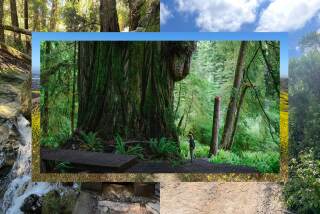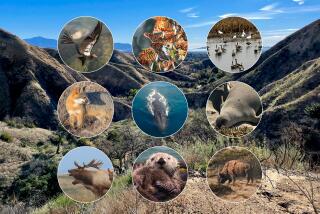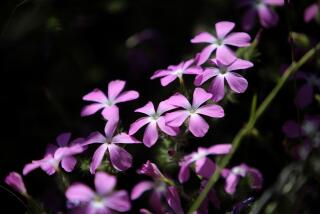In Search of the Elusive Wildflower
Anyone who doubts that wildflowers are a big deal in Southern California hasn’t heard of the Wildflower Hotline. Sponsored by the Theodore Payne Foundation, the hotline--(818) 768-3533--gives you a detailed three minute tape, offering up-to-date information on exactly where which species of flowers are blooming.
A nonprofit organization dedicated to the propagation and preservation of native California flora, the foundation is open to the public Tuesday through Saturday, from 8:30 to 4:30 (10459 Tuxford St., Sun Valley, (818) 768-1802).
Foundation events include:
Next Saturday has been proclaimed “Poppy Day,” by the state, and the foundation will celebrate from 10 a.m. till 4 p.m. with free tours of its grounds and nursery, and advice on landscaping with native plants. Elna Bakker, author of “An Island Called California,” and Matthew Tekulsky, author of “The Butterfly Garden,” will give talks, and rare and endangered plants will be displayed.
Sunday, April 5, Poppy Day continues at the Lummis Home (200 E. Ave. 43, Sun Valley), where visitors can tour the historic home and its drought-tolerant garden.
Saturday, April 25, the foundation will sponsor a wildflower bus tour to the Antelope Valley. Call (818) 768-1802 for details.
ANTELOPE VALLEY
April 4-26, the Lancaster Women’s Club will sponsor its annual Wildflower Center from 9 a.m. to 4 p.m. daily at the Lancaster Museum Art Gallery (44801 N. Sierra Highway, Lancaster, (805) 948-1322). The center offers, among other features, information and maps on wildflowers in the valley, a slide show, and a display of about 85 live flower specimens.
Weekends, through May, the Antelope Valley California Poppy Reserve (15101 W. Lancaster Road, 13 miles west of Lancaster, (805) 942-0662) will feature guided nature walks every Saturday and Sunday at 1 p.m. Administered by the California Dept. of Parks and Recreation, the 1,760-acre park and interpretive center are open daily from 9 to 4 daily till May 4.
JOSHUA TREE NATIONAL MONUMENT
Fifty miles long and 30 miles at its widest, Joshua Tree National Monument ((619) 367-7511) boasts two interpretive centers on its 550,000 acres, the largest located at Twentynine Palms and a smaller one to the south at Cottonwood Springs.
The park’s regularly scheduled events include:
Saturdays at 1:30 p.m., walks featuring information on edible plants.
Sundays at 9 a.m., plant identification workshops at Ryan Campground.
Sundays at 10 a.m., hikes exploring the plants of desert washes.
Fridays at 2:30 p.m., nature hikes through Hidden Valley
Also on Fridays at 2:30, interpreters lead cactus walks through the Cholla Cactus Gardens.
ANZA BORREGO DESERT STATE PARK
Sixty-five miles long, 80 miles wide, and encompassing 600,000 acres, Anza Borrego is the biggest state park outside of Alaska, and boasts over 600 species of plants. The park (open 9 a.m to 5 p.m.) offers frequent interpretive programs, campfire talks, nature walks and an excellent native plant garden and interpretive center, as well as a number of “self-guiding” hiking trails.
April 5-11 is Anza Borrego week. In celebration of its 20th anniversary, the Anza-Borrego Foundation will sponsor a variety of events, including wildflower walks at 10 a.m. Monday through Friday from the State Park Visitor’s Center.
Friday, April 10, botanist Mitchell Beauchamp will lead a California Garden Clubs walk.
Saturday, April 11, the San Diego Chapter of the Native Plant Society will present a “flower show” with labeled wildflowers, followed by a barbecue and open air concert of “classical jazz for the desert.”
ALSO:
Every other Saturday at 9 a.m., the Santa Monica Chapter of the California Native Plant Society meets at the Federal Building in West Los Angeles and heads off in search of wildflowers. The public is invited to go along. Information: (818) 789-5048 or (213) 479-1942.
More to Read
Sign up for The Wild
We’ll help you find the best places to hike, bike and run, as well as the perfect silent spots for meditation and yoga.
You may occasionally receive promotional content from the Los Angeles Times.






